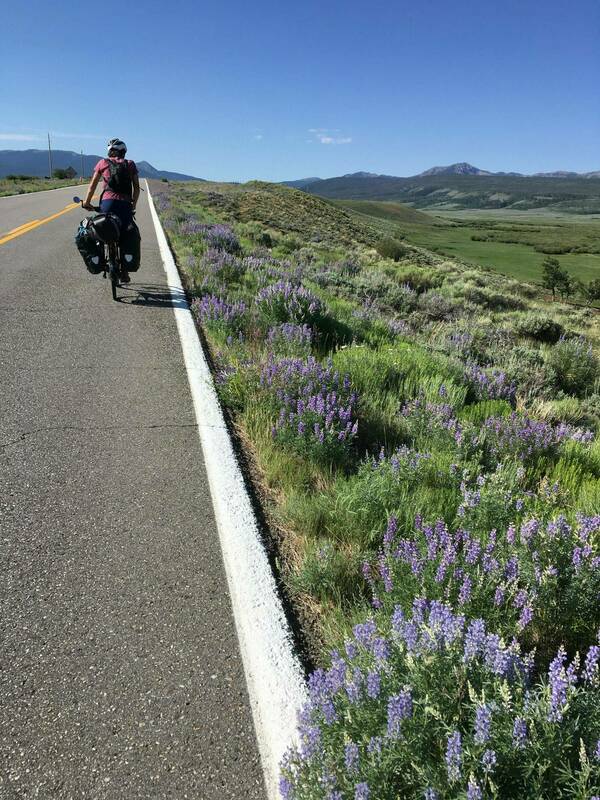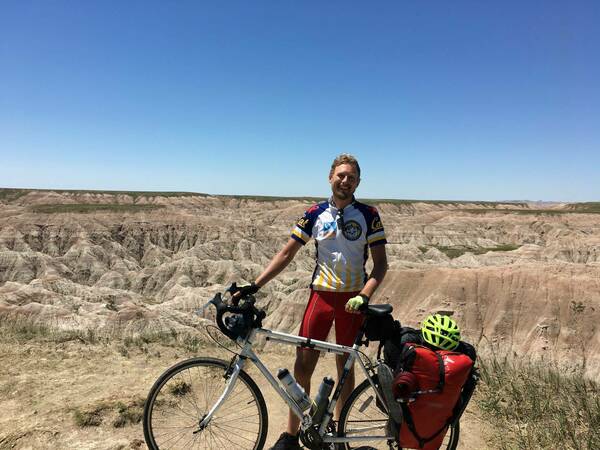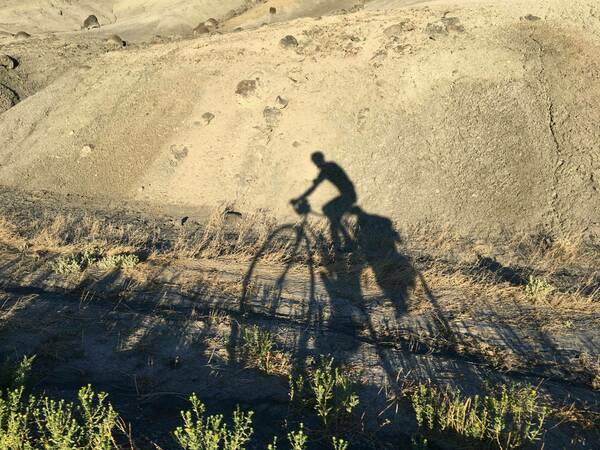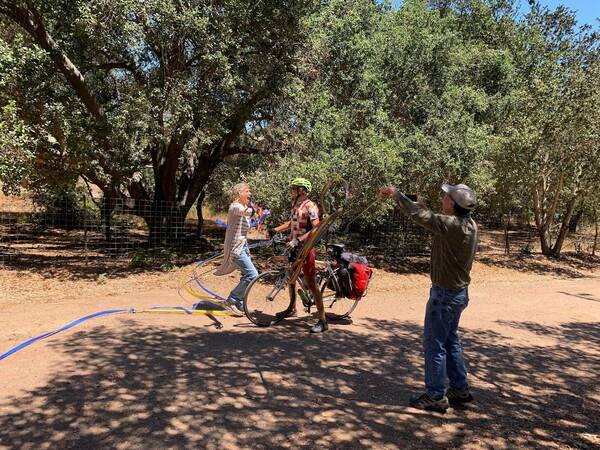
Nicholas Ames, newly minted PhD in Anthropology, capped off his May Commencement ceremony in a unique way: Bicycling across the country to his home in California.
He had already biked to the ceremony from Baltimore.
It was a fitting journey for a scholar of migration.
With a focus on Ireland and Irish America (and advised by Faculty Fellow and Professor of Anthropology Ian Kuijt), Nicholas researches historic migration and the influence immigrant communities have on the development of contemporary urban America. Throughout his time at Notre Dame, he worked on and studied the islands of Inishbofin and Inishark through the Landscapes of the Irish Coast Project, led by Professor Kuijt and Professor of Anthropology Meredith Chesson, also a member of his dissertation committee, as well as along the Killary Coast of southwest Co. Mayo. On the American side, he interviewed families, danced céilí, and studied artifacts in Pittsburgh and Cleveland. [Read about Nicholas' academic work here.]
Nicholas is no stranger to adventure travel. In the summer of 2018 he guest crewed on a Dutch tall ship to better understand the hardships and psychology of a sea passage as part of his dissertation research.
As for his cross-country cycling adventure, Nicholas writes:
"While this ride was a means of reenergizing myself after completing my dissertation, my approach to this journey, like traveling aboard the Tall Ship, was also an immersive process into how we experience time, space, and movements therein. By undertaking these journeys I worked to experience and understand the world —whether past or present—through different lenses."
Read more about his fascinating journey—in which he encountered a bear, rode through thunderstorms, experienced many moments of exhilaration, and some of discouragement. Most importantly, read about Nicholas’ insights on the relationship between people and place.
________________________
I finished my ride on August 10th after 70 days of cycling, 12 states, three flat tires, and 4464 miles.

Despite having minimal experience with long-distance cycling, the thought of riding my bike home to California had been bouncing around my head for a few years. And so, just days after finishing my dissertation defense, I headed out to the East Coast to realize this epic journey. Recognizing my relative ignorance in this type of adventure, I was grateful that my good friend Brendan Croom [PhD University of Virginia ‘19] agreed to come along for the first 800 miles from Baltimore back to South Bend. Although he and I had about the same amount of cycle touring experience (that is to say, very little), he proved to be a stalwart companion for the times when things inevitably went wrong.
Starting at Fort McHenry in Baltimore—where Francis Scott Key found inspiration to pen "The Star Spangled Banner"—our pace was largely dictated by ignorance over what was a reasonable speed and my need to arrive back in South Bend in time for my graduation ceremony, a wedding for which I had agreed to bake the cake, and the end of my housing lease. With the exceptions of trying to navigate out of Pittsburgh and having rain 9 of the 13 days, the joy of pushing myself physically and mentally each day as we traversed westward across Maryland, Pennsylvania, Ohio, and into Indiana began to thaw the stress that had gripped me for the past six years.
After a chaotic weekend of moving, baking, and graduating, I found it surprisingly easy to convince my housemate Ryan Lash [BA Notre Dame ’10, MPhil University of Cambridge ’11, PhD Northwestern University ’19], who had just completed a postdoctoral fellowship at the Keough-Naughton Institute, to join me for a 200-mile stretch up to Madison, Wisconsin, as he, too, was now out of a lease. Continuing with tradition, Ryan had even less experience at cycling than Brendan, having found his bicycle in a dumpster. God bless him.
Continuing solo from Madison, I averaged 63 miles per day, although daily mileage really depended on the local terrain. The flatlands of the Midwest and steep descent out of the Sierra Nevada mountains allowed for days of over 100 miles, with many others in the low 90s. Yet mountain passes, rest days, and poor weather balanced the average out and kept my ego in check.
Throughout the journey I camped the vast majority of the time, my small tent and sleeping pad strapped on top of two 20-liter panniers, which held two changes of shorts, a few jerseys, socks, a jacket, spare tubes, tape, first aid kit, stove, pot, utensils, and one small bottle of soap used universally for my dishes, my body, my hair, and my bike, and enough food for five days (primarily beans. So many beans).
As a whole, the ride was absolutely incredible. Seeing the country from such a slow pace gave me a chance to appreciate the localness of each small town I passed through, as well as experience the constant presence of environment, as I was exposed and beholden to its whims every minute of the journey. It also gave me a sense of how incredibly big the country is.

While I enjoyed the opportunity to cycle every day, there were certainly places that stood out in my mind more than others. Wisconsin had an awesome bike trail system through beautiful wooded hills— I was able to ride through nearly 80% of the state without being on a road! Western South Dakota was also simply stunning. From the Badlands to the Black Hills I cycled through a myriad of landscapes unparalleled in their splendor, finding myself in constant awe of the majesty preserved within the state and national parks. It was just so different from the rolling plains that surrounded me for hundreds of miles (also beautiful, but went on for days . . . ) that the memory stands in stark contrast from the rest. Of course, not every day was a pleasure. In South Dakota I also spent a day battling constant headwinds that gusted up to 23 mph. Nothing is more demoralizing on a bike than having to pedal downhill in order to move forward.
Arriving into Wyoming proved to be a game changer, not only because I crossed the continental divide (meaning, in theory, it was all downhill from there), but because I finally switched out my now-tattered sneakers for a pair of cycling cleats. The difference in power output was astonishing.

The timing of this change was fortunate, because from there my route took me straight south through the heart of the Colorado Rockies. The altitude sickness from riding for a week and a half between 8,000-12,000 feet was made worthwhile by the lush Ponderosa pine and aspen forests that climbed with me up the mountains. As beautiful as the Indiana summer and falls are, the one thing I missed most while living there was the grandeur of the mountains. Of course, camping at altitude in the midst of Colorado forests meant that an encounter with a bear was inevitable. Mine came as I scoped out a site to pitch my tent. Turning around, I saw a large brown bear standing 30 feet away, watching me. A few others at the campsite pulled out their cameras to film as I hooted and hollered and waved my arms until the bear trundled away. The difference in our responses may have been that I was the only one there who was camping in a tent . . .
While I saw no more bears on my journey, just a few days later I was warned by a camp host of an active cougar in the area. As I was the only person at the site, his recommendation was that I “not cook anything smelly and carry a big stick.” I slept well most nights, but that night was not one of them.

As I moved further west and later into the summer, I began to encounter monsoon season. Despite waking earlier and earlier to try and make the day’s distance ahead of the storms, I several times found myself trying to outrace a torrent of rain to my intended destination. One storm in particular arrived earlier than expected as I climbed steeply up Route 12 outside of Capital Reef in Utah. Despite the morning hour, I watched as dark clouds formed higher up the mountain which I rode.The top soon disappeared with a sheet of rain striding down to greet me. In a matter of minutes the temperature had plummeted from 90 to 54 degrees, the rain turned to heavy hail, and cracks of thunder marched closer and closer. I jumped off my bike and huddled low under the trees, absolutely drenched in my jersey and shivering against the unexpected cold. “Great,” I thought, “if I don’t get struck by lightning I’ll probably die of hypothermia. In Utah. In July.”
Having placed my bike a dozen yards or so away, I began to wonder about the metal clips on my cleats as the flashes and cracks of lightning quickly coincided into simultaneous explosions around me, followed by the sweet, pungent smell of ozone. As the storm engulfed me, I knew I needed to get out, fast. After what felt like eternity and several lightning strikes only a few dozen feet away, a godsend in the form of five pickup trucks sloshed their way up the mountain road towards me. I launched myself from the trees and waved them down, undoubtedly looking like a madman in my florescent helmet and checkered jersey standing, drenched, in the rain.
The line slowed and several persons, realizing my situation, jumped out to help lift my bike into the bed before cramming ourselves into the cab and hightailing it out of the localized storm. These kind strangers dropped me off at a lookout higher up the mountain, beyond the edge of the storm. As I dried myself off, shivering from fear as much as the cold, and watched the storm in the distance still parked where I had been, I tried to come to terms with the fact that it is likely only by the fortuitous timing and selfless compassion of those drivers that I was still alive. With my heart in my throat, I pedaled onward and soon found myself in a construction line-up a few miles down the road. How surreal life is when, only minutes from fearing for your life, you find yourself mundanely stuck in traffic.
Despite the many ups and downs, I was blown away by the incredible, stark beauty of Utah’s canyonlands. Riding on small highways through sparsely populated desert at my relatively slow pace often meant days without seeing a building, let alone a store to resupply. As a result I had the red spires and steep undulating climbs mostly to myself as I wove in and around the timeworn desert etched by powers beyond human conception. Often being the only person at a campsite, the quiet nights, fiery sunsets, and powerful storms that vaulted this splendor beyond the horizon and into the heavens were my own to behold.
Traveling across the country gave me the to opportunity to visit a few friends as well as to make new ones along the way. Invariably, on a journey like this, I frequently cross paths with others undertaking a similar adventure—whether by bike or on foot—each with their own ambitions and personal histories driving them onward. Among those traveling in the same direction I would often find a riding companion for a few hours or days until our respective routes or pace would move us apart. Many times I would see the same persons at a campsite for several days running as we accordioned along the road, experiencing our respective journeys alone together.

I eventually arrived into San Francisco completing the coast-to-coast ride on August 5. Coming over the coast ranges to glimpse the San Francisco Bay for the first time brought a hard realization that I was almost home.
While cycling, I tried not to envision the journey in its entirety to avoid becoming overwhelmed. Yet, even so, it would have been difficult to conceptualize how large the country is until it was experienced mile by mile. Instead, I tried to focus on the day-to-day – how far I planned to ride, which route to take, what I would eat, and where I would stop for the night. The idea of 4,500 miles seemed a daunting task, whereas cycling only 70 miles each day was a feasible goal. I just continued to hold that smaller goal day after day after day. The approach was the same one I used to write my dissertation. And, thankfully, cycling needs no edits. The mileage achieved each day eventually strung together until I found myself standing on the cusp of the Pacific, where the last coast I’d touched—two months earlier—had been the waters of the Atlantic.
Being able to ride no further west, I turned myself southward, the final 280 miles towards home now seeming a drop in the bucket within the totality of the ride.
After so long on the road, the anticipation of arrival felt surreal. I’m not sure at which point I stopped using a map, but moving through an increasingly familiar landscape I found myself with a very clear picture of where to go and which turns to make. Seeing these familiar places from the saddle and speed of a bike seemed all new as I spent several days traversing a coastline that had previously taken only a few hours to pass. Yet, eventually, I turned away from the shore, crested the final hill, and cycled up a last, quiet stretch of road which I had driven a thousand times. Pulling into our long, dirt driveway I heard the cheers and shouts of my family waiting to greet me. They had strung a ribbon across the drive and, as I rode my final pedal through, the emotions of the moment—in seeing my family and the completion of two enormous adventures I had lain before myself (one intellectual and one physical)—crested and broke in overwhelming waves.
While this ride had been partially a means of reenergizing myself after completing my dissertation, my approach to this journey, like traveling aboard the Tall Ship, had been an immersive process into how we experience time, space, and movements therein. By undertaking these journeys I worked to experience and understand the world —whether past or present—through a multitude of lenses. Being on the road for so long, exposed to sun, rain, hail, and wind, and interacting intimately with the spaces through which I moved made me think a lot about how we, as a society, interact with environments—particularly in regards to technology. While I struggled through the headwinds of South Dakota—their powerful gusts consuming my energy and shaping the reality of my experience—individuals passing in cars just feet away were likely unaware of the powerful force except for peripheral indicators seen through the windshield. Whether at campsites or on the road, I was constantly aware of the surrounding environment simply by the nature of my exposure to it. Each cloud that moved to cover the sun, each drop of rain that signaled an impending storm, and the absence or presence of a breeze would influence my day, and my thoughts, as much as the logistics of whatever goal I set. And the logistics themselves were often largely dictated by the environments through which I moved—the timing of departures and arrivals based on predicted weather patterns or anticipated terrain—starting early to beat storms, avoid heat, or tackle a looming mountain.
And there was much more to the immersive experience than just weather and terrain. I encountered incredible vistas, sunrises, and interactions—such as racing an antelope down a silent road in Wyoming. The kindness of strangers outweighed the hostility of others, although both were present along the ride. And alongside the beauty I also witnessed the carnage brought about by speeding cars as countless creatures—thousands of birds, foxes, deer and boars—lay lifeless on the edge of the road. My reality and the reality of those around me, and the relationship and awareness they had with these environments, were completely different based on technologies of travel and comfort. I realized that while our tendency to live in insulated and conditioned homes and vehicles provides comfort, it also provides a separation from the world's surroundings. With an approaching storm, a driver can simply roll up their window and turn up the radio to drown out the thunder and lightning. Not so on a bicycle. The severity of weather and its implications have become inconsequential for those insulated from its power. We are no longer living within the environment, but rather alongside it. This is why so many people can ignore or deny the idea that humans have had a significant impact on the climates of the world, and that those environments are changing as a result—because they never have to physically experience a 116-degree day, walk the distance between an old boat ramp and the receded flow of the Colorado River, or see the effects on an ecological system of an increasing number of flash floods caused by the growing intensity of summer storms. Rather, we simply sit adjacent to those realities and watch reports of them on the evening news from within our own constructed environments.
My approach to research and personal journeys through immersive experiences have brought me to this realization of the relationship between people and place, and the long-term impact these short-term technological "advances" may have. This is not to say that how we utilize technology is incompatible with an awareness of the environment. On the contrary, I think technology is our best solution for creating a balanced relationship between the societies we have built and the environments in which we live. But I think it is crucial that we create greater awareness of our environments through immersive experiences so that people understand where they actually live, and what a change to those environments actually means.
[Read about Nicholas' academic work here.]

Homecoming
Originally published by at irishstudies.nd.edu on October 07, 2021.